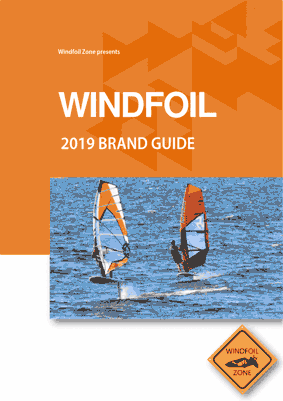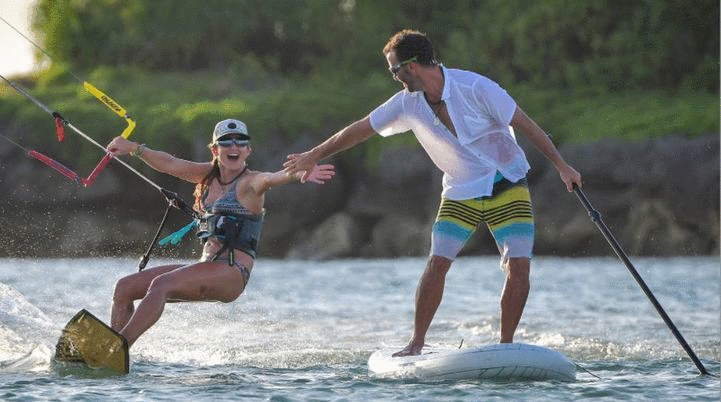New generations of windsurfers thanks to foiling. Windsurfing is not dead!
- .

- Dec 15, 2019
- 6 min read
Updated: Feb 28, 2020
Up until 2017, windsurfing was decreasing in popularity, slowly but surely. «Nobody» wanted to learn windsurfing any more. Kitesurfing looked so much cooler and of course young people were naturally attracted to it.
The lack of recruitment into the sport is also very visible today, as there are few windsurfers under the age of 40 – you can see this when you try and count the younger ones out on the beach.
Fortunately, windfoiling emerged not too long ago and people’s enthusiasm for windsurfing is growing again. We hear every day people who stopped windsurfing many years ago, fed up with always waiting for the wind to pick up, but now they are returning to the sport to check out windfoiling with excitement and motivation.
Read also:
But the real change is that we also see new people, and kids in particular, who are interested in the sport and they are starting to book lessons in their nearest windsurfing club. (check out our windfoil directory to find your nearest windsurfing club proposing windfoiling!)
Getting new young windfoilers is very important for the longevity of the sport, and windsurf clubs have understood that. Now that windfoiling will finally replace the RS:X for the Paris 2024 Olympics, we should also start to see many teenagers practice windfoiling seriously, with a hope to participate the summer Olympics in France.
To get a better understanding of the growing interest and enthusiasm for windfoiling and get an overall feeling of where things are currently on the spots, we’ve discussed with a couple of experts in teaching people into foiling. They share their observations and experiences in teaching beginners how to foil:
- Marcello Morrone, of Clube Katanka, Lake Paranoá, Brasília, Brazil.
- Alan McIntosh, of Madloop Windsurfing, Lake Pupuke, New Zealand
Windfoil Zone: Could you tell us when you started to teach windfoiling in your club?

Marcello: We started to make the first tests by the end of 2017. Since then, we have been constantly updating our equipment and the methods to make it easier to learn.
Alan: We have been teaching windfoiling since August 2017
How many people have you taught so far?
Marcello: Approximately 40.
Alan: We have taught so many people to windfoil. I couldn't even guess, as we are open all year round. And nearly every one who learns with us, then learns how to WindFoil!
How many of them were complete beginners (not windsurfers)?
Marcello: About 5% but the goal is to go straight from the daggerboard to foiling , so, 100% of our regular Windsurfing students will be encouraged to go windfoiling as the next step.
After only 3 years, we see more windfoil boards flying here than any other conventional boards planing. Every newcomer that visits us to learn is because of our windfoiling focus.
In other words, for those who don’t know the sport very well, windfoiling is naturally becoming the new Windsurfing.
Alan: It is very normal for us to get someone who has never windsurf before into windfoiling after 12 to 14 hours. Other people who have never windsurfed before, but are good at sailing, dinghies, Laser Moths etc… are learning how to windfoil on their 6 th to 8 th hour.
So, as you can imagine, this is game changing stuff. People come off the water, completely buzzing. And can't wait to foil again. People who can already windsurf, we can get them immediately foiling within the first 80 metres of leaving the land!
In New Zealand, this is having a big impact, loads of people are buying windfoil gear, and we have a strong freeride foil scene and lots of people are attracted to this new scene.
What is your strategy in teaching people how to windfoil?
Marcello: The idea is to start with 4 hours on standard beginner windsurfing equipment, but with a totally new methodology focusing on learning the basics of windfoiling.

For example, it wasn’t a common practice to teach pumping techniques for students before, but now with foiling they will need to pump to keep using small sails when foiling.
Another important point is to invest in the correct equipment for beginners. They should start foiling in low speeds to get the skills and gain confidence. Windsurfers can migrate to foiling with more performance foils with no problem. The progression is quite fast and pleasant.
(Read also: LEARN HOW TO WINDFOIL: 10-STEP BEGINNER'S GUIDE)
Alan: At MadLoop WindSurf School, people who have never windsurfer before start off on a Starboard Rio, 330 x 82.5. We teach these people just tacking and gibing. As soon as they can lean back, hang off the rig, we then go straight to the windfoil.
We have helped develop a foil with Axis, and we use this on a Starboard board, that is about 90 cm wide.
(Read also: Experts give their best to windfoil beginners)
At what age can a child start learning how to foil?
Marcello: 12-13 years old. But I’ve seen younger kids flying beautifully on Windfoil Zone’s Instagram account !
Alan: Normal age that children here are learning to WindFoil, are from 11 years old.
We also have 4 x 70 year old windfoilers here in Auckland. So that's what's magic about this, is that anyone ,and everyone can do this.

Alan teaching his 10-years old son how to windfoil!
What are your best tips for complete beginners to learn foiling?
Marcello: The most important thing is you have to forget the myth that windfoiling is a sport that is too dangerous or difficult sport to learn. With modern equipment, the basics of windsurfing can be learned in 60 minutes.
We can accelerate the learning of foil skills towing the student with a motor boat. But a good windy day is definitely much better than a light and gusty wind day for learning.
So, to choose the best condition is crucial.
(Read also Marcello's previous interview: How Windfoiling Has Become a Game Changer In Light-Wind Windsurf Destinations)

Alan: Windfoiling has transformed Windsurfing. It’s a high performance sport, that is easy to learn, radical, and super addictive.
To the people that haven't tried it: The reason why we are so addicted to this is that, we can be fully powered, in so little breeze. The gear is easy to use, as there is no drag once we are flying. And the sensation, is that of surfing in the air. So much fun!
How do you see the future of windfoiling?
Marcello: Windfoiling has the potential to keep growing.
Many windsurfers are coming back to the sport as they don’t need very strong winds anymore. The equipment is more compact and has a larger wind range also. I think windsurfing schools should open their eyes and see this new perspective.
And, of course, everybody will see the new IQ Foil Olympic class during the Paris 2024 Olympic Games, which is much more attractive than the RSX class. The media exposure should be great for the sport too. Great times are coming!
I’m very curious about wingfoiling (this new sport emerging in 2019, with just a foil board and an inflatable wing). I can’t wait to try it too!
Alan: I think, that with all the development, for freeride and racing, the windfoil buzz will just get stronger and stronger. And more and more people will be windfoiling everywhere.
Thank you! Any final words for our windfoil community?
Marcello: Thank you WindFoil Zone!
At Katanka we’re very much focused on windfoiling and I’m sure that we’ll see the sport growing next year. Let´s enter 2020 flying!!
Alan: Let's get out there on the windfoil. If you are coming to Auckland NZ, I can teach, or rent you a windfoil !!!
Beginners stories:

Rui Nascimento is Olympic Silver medalist, playing voleyball in the 80's. He started windsurfing in the light wind city of Brasilia when he turned 54 years old. 1,98 cm tall and 120 kg!
After learning the basics he started on a formula windsurfing board with a 12.5 sail, which is not the ideal for 50+ beginner windsurfer, won't you agree?
Today he´s flying with his Starboard Super Cruiser Foil (1700 cm2 front wing) with the same Formula board but only a 8.5 sail! This has been a game changer for him.

Luiz Neves was Katakan's first newcomer going straight from beginner daggerboard board to foil.
As Brasilia is a light wind venue, only race/freerace equipment were working. Luiz has now purchased a foil freeride equipment
(Starboard Foil X 145 powered by a 7.0m2 Severne Foil Glide sail with 2-cams)

Matthew McIntosh - Alan's son - tried Windfoiling for the first time when I was 10 in 2017 and
he was one of the world's youngest windfoiler. He learned at Lake Pupuke Madloop Windsurf School. You can read his interview here.











Comments